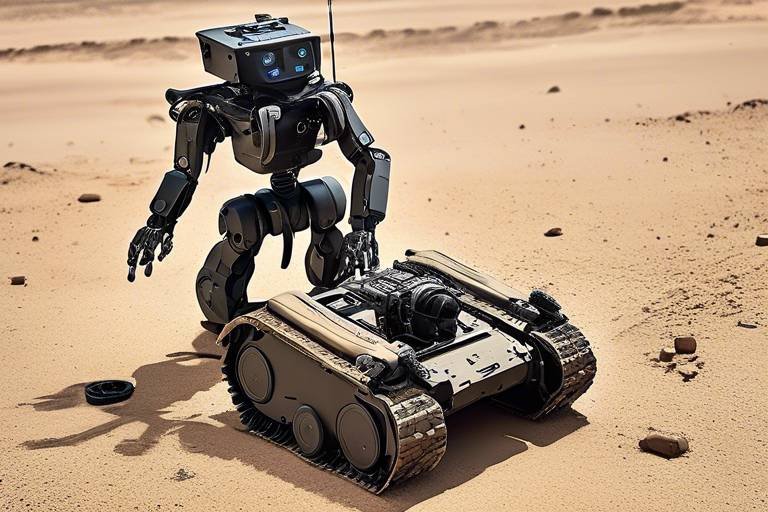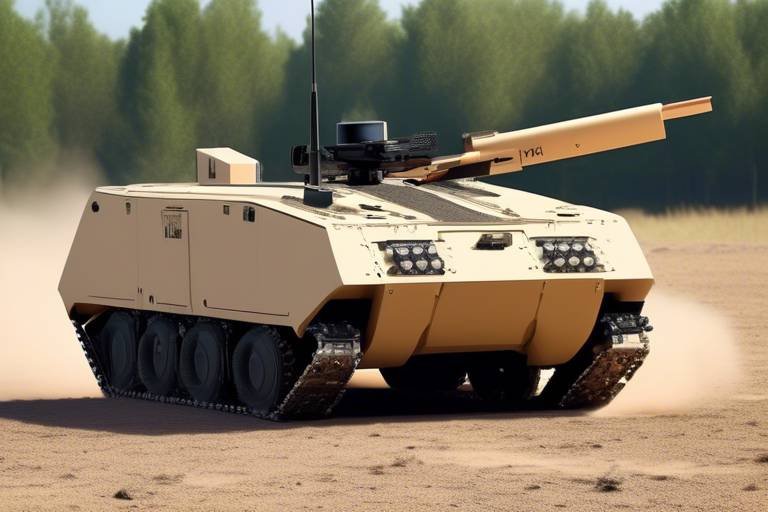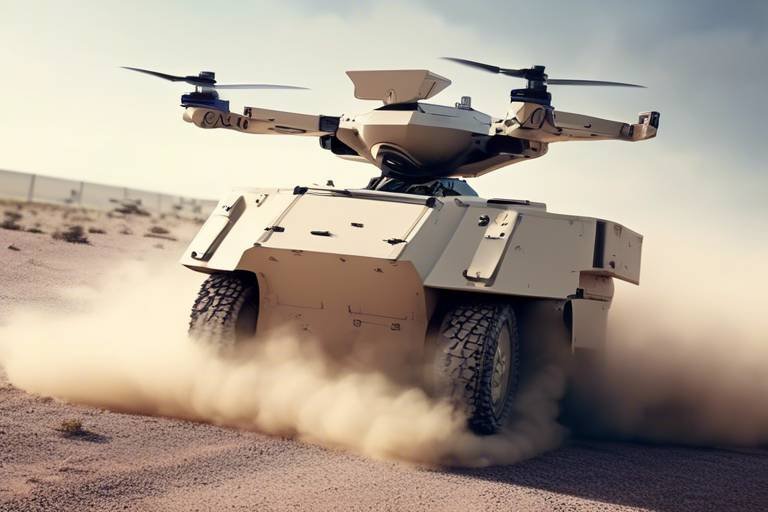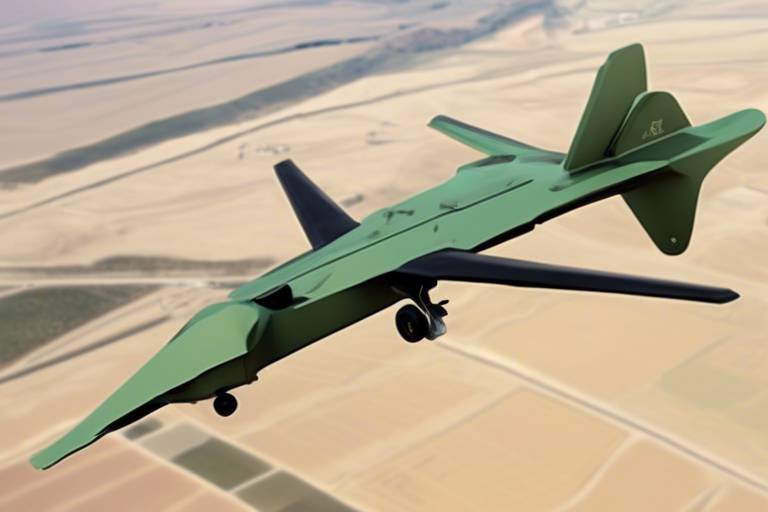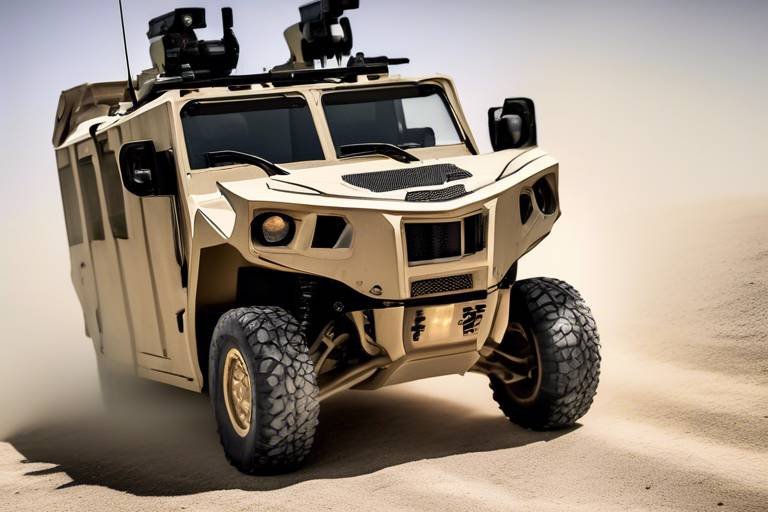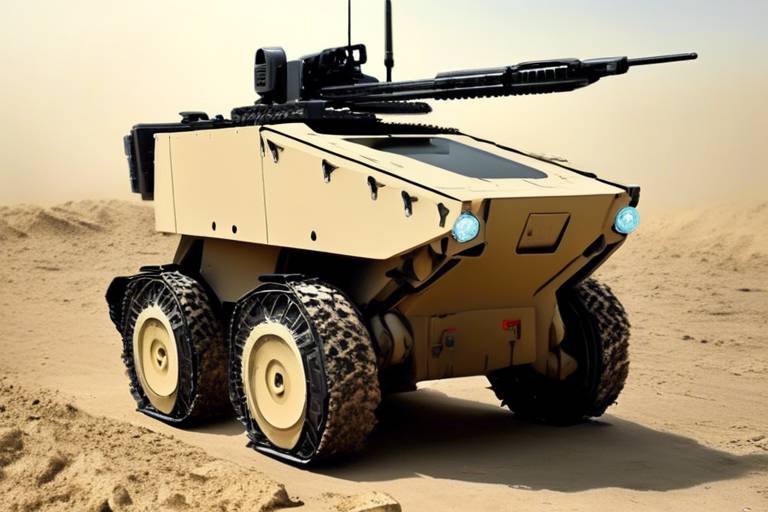The Role of the QinetiQ Talon Robot in EOD Operations
The world of Explosive Ordnance Disposal (EOD) is fraught with danger, where every second counts and the stakes are incredibly high. In this arena, the QinetiQ Talon robot emerges as a game-changer, revolutionizing how we approach the neutralization of explosive threats. Imagine a machine that can venture into the most perilous environments, equipped with advanced technology, and operated remotely to keep human lives safe. This article delves into the significance of the Talon robot, showcasing its capabilities, applications, and its profound impact on safety and efficiency in the field.
When it comes to EOD operations, the challenges are immense. Professionals in this field utilize specialized techniques and cutting-edge equipment to safely neutralize explosive threats. The complexity of these operations demands not just skill but also a deep understanding of the risks involved. By grasping the context and challenges of EOD tasks, we can truly appreciate the role that robots like the QinetiQ Talon play in enhancing safety and operational effectiveness. The Talon isn't just a tool; it’s a lifeline for EOD teams working in high-risk environments.
The QinetiQ Talon robot is not your average unmanned ground vehicle; it’s a versatile asset designed for a multitude of missions. Its robust design and advanced features make it particularly valuable in hazardous environments, especially during EOD scenarios. Think of it as a Swiss Army knife for bomb disposal—capable of adapting to various tasks and challenges with ease. Whether it’s conducting reconnaissance or neutralizing a bomb, the Talon has been engineered to excel under pressure.
The Talon robot boasts a rugged design that can withstand the rigors of challenging terrains. Its all-terrain capabilities and modular components enable it to navigate diverse landscapes, from rocky mountains to urban debris. This adaptability is crucial in EOD operations where the environment can change in an instant. Here are some of the standout design features:
- Rugged Construction: Built to endure harsh conditions.
- All-Terrain Mobility: Capable of traversing rubble and steep inclines.
- Modular Components: Easily customizable for various tasks.
The Talon's unique mobility allows it to traverse difficult terrains that would pose significant challenges for traditional vehicles. Picture a nimble dancer navigating a crowded stage—this robot can weave through obstacles, making it an invaluable asset in scenarios where human access is limited or too dangerous.
One of the most impressive aspects of the Talon is its customizable payload options. It can be equipped with various tools and sensors, enhancing its functionality for specific EOD tasks. This adaptability means that the Talon can switch roles as needed, whether it’s carrying a bomb disposal tool or a high-resolution camera for reconnaissance missions. The versatility of the Talon robot significantly improves mission adaptability and response times.
The QinetiQ Talon robot is deployed in numerous EOD applications. From reconnaissance missions that scout for potential threats to the actual neutralization of explosive devices, the Talon enhances operational safety and efficiency. By utilizing this robot, teams can focus on strategy and execution without the constant fear of personal injury. The deployment of the Talon not only reduces risks for personnel but also streamlines the entire EOD process.
Integrating robots like the Talon into EOD operations brings a plethora of benefits. The most significant advantages include:
- Enhanced Safety: Minimizing personnel exposure to danger.
- Operational Efficiency: Streamlining EOD processes for quicker assessments.
- Improved Situational Awareness: Offering real-time data and insights during missions.
By deploying the Talon robot to handle explosive threats, EOD teams can significantly reduce their exposure to danger. Imagine being able to neutralize a bomb from a safe distance—this is the reality that the Talon provides. The risk of injury or fatality is drastically lowered, allowing personnel to focus on their mission without the looming threat of immediate danger.
The use of the Talon robot streamlines EOD processes, allowing for quicker assessments and neutralizations of threats. This efficiency can lead to faster mission completions and reduced downtime. In the world of EOD, time is of the essence, and the Talon robot plays a crucial role in ensuring that operations run smoothly and efficiently.
Despite its myriad advantages, the QinetiQ Talon robot is not without challenges. Technical limitations, environmental factors, and the need for skilled operators can hinder its effectiveness. Understanding these challenges is crucial for effective deployment.
While the Talon is equipped with advanced technology, it may encounter limitations in certain environments. For instance, extreme weather conditions or complex urban settings can challenge its operational capabilities. It’s a bit like trying to drive a sports car on a rugged mountain trail—sometimes, the terrain just isn’t suitable.
Effective utilization of the Talon requires trained personnel who can operate the robot and interpret its data. Ensuring operators are well-trained is essential for mission success. Just as a skilled pilot is necessary to fly an aircraft, the same goes for operating the Talon robot. Without the right expertise, even the most advanced technology can fall short.
The field of EOD robotics is continually evolving, with advancements in technology promising to enhance the capabilities of robots like the Talon. Future developments may lead to even safer and more efficient operations, potentially integrating artificial intelligence and machine learning to improve decision-making processes. The future of EOD operations looks bright, and the Talon is poised to be at the forefront of this evolution.
- What is the primary function of the QinetiQ Talon robot? The Talon robot is primarily used in EOD operations to safely neutralize explosive threats and enhance operational safety.
- How does the Talon improve safety for EOD teams? By allowing remote operation, the Talon minimizes personnel exposure to dangerous situations, significantly reducing the risk of injury.
- What are some limitations of the Talon robot? The Talon can face challenges in extreme weather conditions and requires skilled operators for effective deployment.

Introduction to EOD Operations
Explosive Ordnance Disposal (EOD) operations are critical missions that involve the identification, evaluation, and neutralization of explosive threats. These operations are not just about defusing bombs; they encompass a broad spectrum of activities that ensure the safety of civilians and military personnel alike. Imagine walking through a bustling market or a crowded event, only to discover that there is a hidden explosive device lurking nearby. The stakes are incredibly high, and that’s where EOD teams come into play. They are the unsung heroes, equipped with specialized techniques and advanced technology to tackle these dangerous situations head-on.
The challenges faced during EOD operations are immense. Teams often work in unpredictable environments, which may include urban areas, remote locations, or even war zones. The pressure is palpable; every second counts, and the margin for error is razor-thin. To effectively neutralize explosive threats, EOD professionals must possess not only technical expertise but also a deep understanding of the various types of explosives they may encounter. This knowledge is essential for assessing risks and determining the safest approach to each unique situation.
In recent years, the integration of robotics into EOD operations has revolutionized the field. Robots like the QinetiQ Talon have become invaluable assets, allowing teams to operate with increased safety and efficiency. By deploying these machines, EOD personnel can minimize their exposure to danger while still effectively managing explosive threats. The use of robots not only enhances operational safety but also streamlines the entire process, making it quicker and more effective.
To truly appreciate the role of robots in EOD, it’s important to understand the various phases of an EOD operation. Typically, these phases include:
- Reconnaissance: Gathering information about the threat.
- Assessment: Evaluating the risk and deciding on a course of action.
- Neutralization: Safely disarming or destroying the explosive device.
- Post-incident analysis: Reviewing the operation to improve future responses.
Each of these phases presents its own set of challenges, and the incorporation of advanced robotics can significantly enhance the effectiveness of EOD teams. With tools like the Talon robot, the complexity of these operations can be managed more effectively, allowing for a safer resolution to potentially life-threatening situations.
As we delve deeper into the capabilities and applications of the QinetiQ Talon robot, it becomes clear that the future of EOD operations is not just about human bravery but also about leveraging technology to save lives. The combination of human expertise and robotic precision is paving the way for a new era in explosive ordnance disposal.

Overview of the QinetiQ Talon Robot
This article explores the significance of the QinetiQ Talon robot in Explosive Ordnance Disposal (EOD) operations, highlighting its capabilities, applications, and impact on safety and efficiency in the field.
EOD operations require specialized techniques and equipment to safely neutralize explosive threats. Understanding the context and challenges of these operations is essential for appreciating the role of robots like the QinetiQ Talon.
The QinetiQ Talon robot is a versatile unmanned ground vehicle designed for various missions, particularly in the high-stakes world of EOD operations. Its robust design and advanced features make it a valuable asset in hazardous environments. Imagine having a reliable companion that can venture into danger zones, assess threats, and even neutralize explosives without putting human lives at risk. The Talon robot does just that, embodying the perfect blend of strength and intelligence.
One of the standout features of the Talon is its modular design, which allows for a customizable approach to each mission. Operators can equip the robot with a variety of tools and sensors tailored to the specific needs of an operation. This adaptability not only enhances its functionality but also ensures that it can tackle a range of scenarios effectively. For example, the Talon can be outfitted with:
- Camera systems for real-time surveillance
- Manipulators for handling suspicious objects
- Explosive detection sensors to identify potential threats
Moreover, the Talon robot is engineered for all-terrain mobility, enabling it to traverse a wide array of landscapes—from urban rubble to rugged terrain. This capability is crucial during EOD missions where the environment can be unpredictable and challenging. The robot's ability to maneuver through tight spaces and over obstacles ensures that it can reach explosive devices that may be hidden or buried in difficult-to-access locations.
The design features of the Talon robot are not just for show; they are meticulously crafted to enhance its performance in the field. Key attributes include:
| Feature | Description |
|---|---|
| Rugged Construction | Built to withstand harsh environments and impacts. |
| Modular Components | Allows for customization based on mission requirements. |
| Advanced Sensors | Equipped with state-of-the-art technology for threat detection. |
The Talon's unique mobility allows it to traverse difficult terrains, including rubble and steep inclines, ensuring effective operation in various environments where traditional vehicles may struggle. This is particularly important in EOD operations where every second counts, and the ability to navigate quickly can mean the difference between success and failure.
With its customizable payload options, the Talon can be equipped with various tools and sensors, enhancing its functionality for specific EOD tasks and improving mission adaptability. The flexibility in payload capacity ensures that the robot can be tailored to meet the specific demands of each mission, making it an invaluable tool in the arsenal of EOD teams.
The Talon robot is utilized in numerous EOD applications, from reconnaissance to neutralization of explosive devices. Its deployment enhances operational safety and efficiency, reducing risks for personnel. By taking on the most dangerous tasks, the Talon allows human operators to maintain a safe distance from potential threats, significantly increasing the overall safety of EOD operations.
Integrating robots like the Talon into EOD operations provides significant advantages, including improved safety for bomb disposal teams, increased operational efficiency, and enhanced situational awareness during missions.
By deploying the Talon robot to handle explosive threats, EOD teams can minimize their exposure to danger, significantly reducing the risk of injury or fatality during operations. This capability is not just a technological advancement; it represents a fundamental shift in how we approach explosive threats.
The use of the Talon robot streamlines EOD processes, allowing for quicker assessments and neutralizations of threats. This efficiency can lead to faster mission completions and reduced downtime, ultimately saving lives and resources.
Despite its advantages, the QinetiQ Talon robot faces challenges, including technical limitations, environmental factors, and the need for skilled operators. Understanding these challenges is crucial for effective deployment.
While the Talon is equipped with advanced technology, it may encounter limitations in certain environments, such as extreme weather conditions or complex urban settings that challenge its operational capabilities.
Effective utilization of the Talon requires trained personnel who can operate the robot and interpret its data. Ensuring operators are well-trained is essential for mission success.
The field of EOD robotics is continually evolving, with advancements in technology promising to enhance the capabilities of robots like the Talon. Future developments may lead to even safer and more efficient operations.
- What is the QinetiQ Talon robot used for?
The Talon robot is primarily used in Explosive Ordnance Disposal (EOD) operations to safely neutralize explosive threats. - How does the Talon enhance safety during EOD missions?
By handling dangerous tasks, the Talon minimizes human exposure to explosive threats, significantly reducing the risk of injury or fatality. - Can the Talon operate in all terrains?
Yes, the Talon is designed for all-terrain mobility, allowing it to navigate various environments effectively. - What are some of the challenges faced by the Talon?
Challenges include technical limitations in extreme conditions and the need for skilled operators to manage its operations.
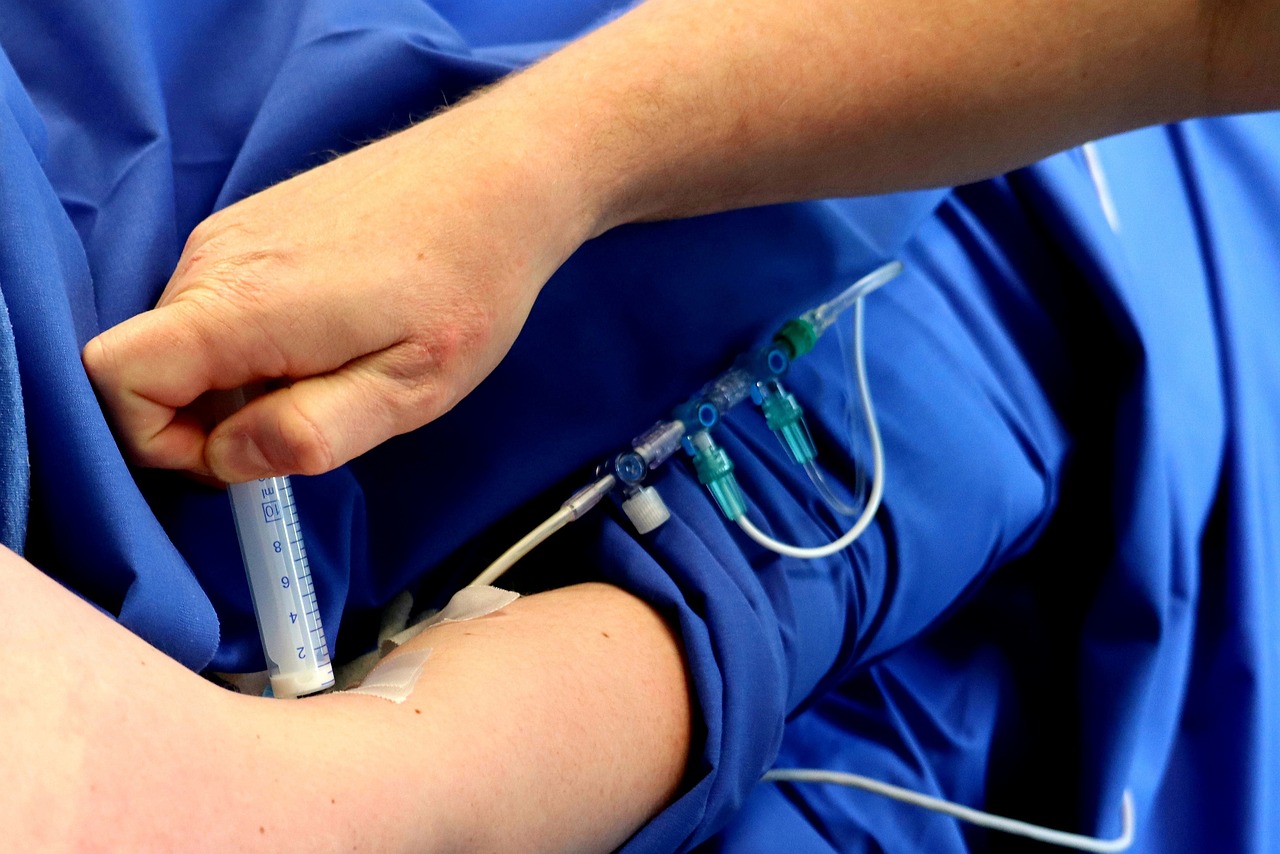
Design Features of the Talon Robot
The QinetiQ Talon robot is not just another piece of machinery; it's a marvel of engineering designed to tackle some of the most dangerous tasks in Explosive Ordnance Disposal (EOD) operations. One of the standout features of the Talon is its rugged design, which allows it to withstand the harshest environments. Whether it’s navigating through rubble after a disaster or traversing steep inclines in a remote area, the Talon’s all-terrain capabilities ensure it can go where traditional vehicles might falter.
What truly sets the Talon apart is its modular design. This means that the robot can be customized with various attachments depending on the mission at hand. For instance, it can be equipped with robotic arms for manipulation, cameras for surveillance, or even sensors for detecting explosives. This flexibility makes the Talon a valuable asset in a wide range of EOD scenarios, adapting to the specific needs of each mission.
Moreover, the Talon robot boasts impressive mobility and maneuverability. Its unique wheel and track system allows it to navigate through challenging terrains that would typically pose significant obstacles. Imagine a small tank that can crawl over debris, climb up steep hills, and even maneuver through tight spaces—this is the Talon in action. Its design enables it to pivot and turn in place, making it incredibly agile and efficient in environments where every second counts.
In terms of payload capacity, the Talon is designed to carry a variety of tools and equipment. This feature is crucial as it allows EOD teams to deploy the robot with the necessary gear for specific tasks. For example, during a bomb disposal operation, the Talon can be loaded with disruptor devices or other specialized tools that enhance its effectiveness. This adaptability not only improves mission success rates but also ensures that the robot can handle multiple roles, from reconnaissance to direct engagement with explosive devices.
To summarize, the design features of the QinetiQ Talon robot make it a formidable partner in EOD operations. Its rugged, modular, and agile design allows it to perform effectively in diverse environments while carrying out a range of tasks. As technology continues to advance, we can only expect the Talon to evolve further, enhancing its capabilities and solidifying its essential role in keeping EOD personnel safe.
- What is the primary purpose of the Talon robot?
The Talon robot is primarily used for Explosive Ordnance Disposal (EOD) operations, helping to safely neutralize explosive threats. - Can the Talon operate in harsh weather conditions?
While the Talon is designed for rugged environments, extreme weather conditions can still pose challenges to its operation. - How is the Talon controlled?
The Talon is typically operated remotely by trained personnel who can control its movements and interpret data from its sensors. - What types of payloads can the Talon carry?
The Talon can be equipped with various payloads, including cameras, robotic arms, and disruptor devices, depending on the mission requirements.

Mobility and Maneuverability
The QinetiQ Talon robot is a marvel of engineering, particularly when it comes to its . Imagine navigating through a chaotic battlefield or a disaster zone where traditional vehicles might falter. The Talon is designed to excel in such challenging environments, equipped with a unique set of features that allow it to traverse a variety of terrains with ease. Its robust, all-terrain capabilities mean that it can handle everything from rocky surfaces to muddy fields, making it a versatile ally in Explosive Ordnance Disposal (EOD) operations.
One of the standout features of the Talon is its tracked mobility system. This system provides exceptional traction and stability, allowing the robot to climb steep inclines and maneuver over obstacles that would stop most vehicles in their tracks. For instance, whether it's navigating through debris after an explosion or traversing a rugged landscape, the Talon can maintain its balance and function effectively. This capability is critical in EOD missions, where the terrain can be unpredictable and hazardous.
Additionally, the Talon robot is equipped with a sophisticated articulated arm that enhances its maneuverability. This arm can be deployed to manipulate objects, conduct inspections, or even disarm explosives from a safe distance. The flexibility of the arm allows the Talon to perform intricate tasks that require a delicate touch, all while keeping human operators at a safe distance from potential threats.
Moreover, the Talon’s design includes a compact and lightweight structure, which contributes to its agility. It can swiftly navigate tight spaces and confined areas where larger vehicles would struggle. This feature is particularly advantageous in urban settings, where explosive devices may be hidden in hard-to-reach locations. The ability to move quickly and efficiently can mean the difference between a successful mission and a catastrophic failure.
In summary, the mobility and maneuverability of the QinetiQ Talon robot are not just technical specifications; they are vital characteristics that enhance its effectiveness in EOD operations. By combining tracked mobility with an articulated arm and a lightweight design, the Talon can adapt to various challenges, ensuring that it remains a crucial asset in the fight against explosive threats.
- What types of terrains can the Talon robot navigate?
The Talon robot can navigate a wide range of terrains, including rocky surfaces, mud, rubble, and steep inclines, making it highly versatile in various environments. - How does the Talon robot enhance safety during EOD operations?
By handling potentially explosive devices remotely, the Talon robot minimizes the risk to personnel, allowing them to maintain a safe distance from danger. - Can the Talon robot be used in urban environments?
Yes, the Talon is designed to maneuver in tight spaces and confined areas, making it suitable for urban EOD operations. - What kind of tasks can the Talon perform during EOD missions?
The Talon can perform a variety of tasks, including reconnaissance, object manipulation, and neutralization of explosive devices, thanks to its customizable payload options.
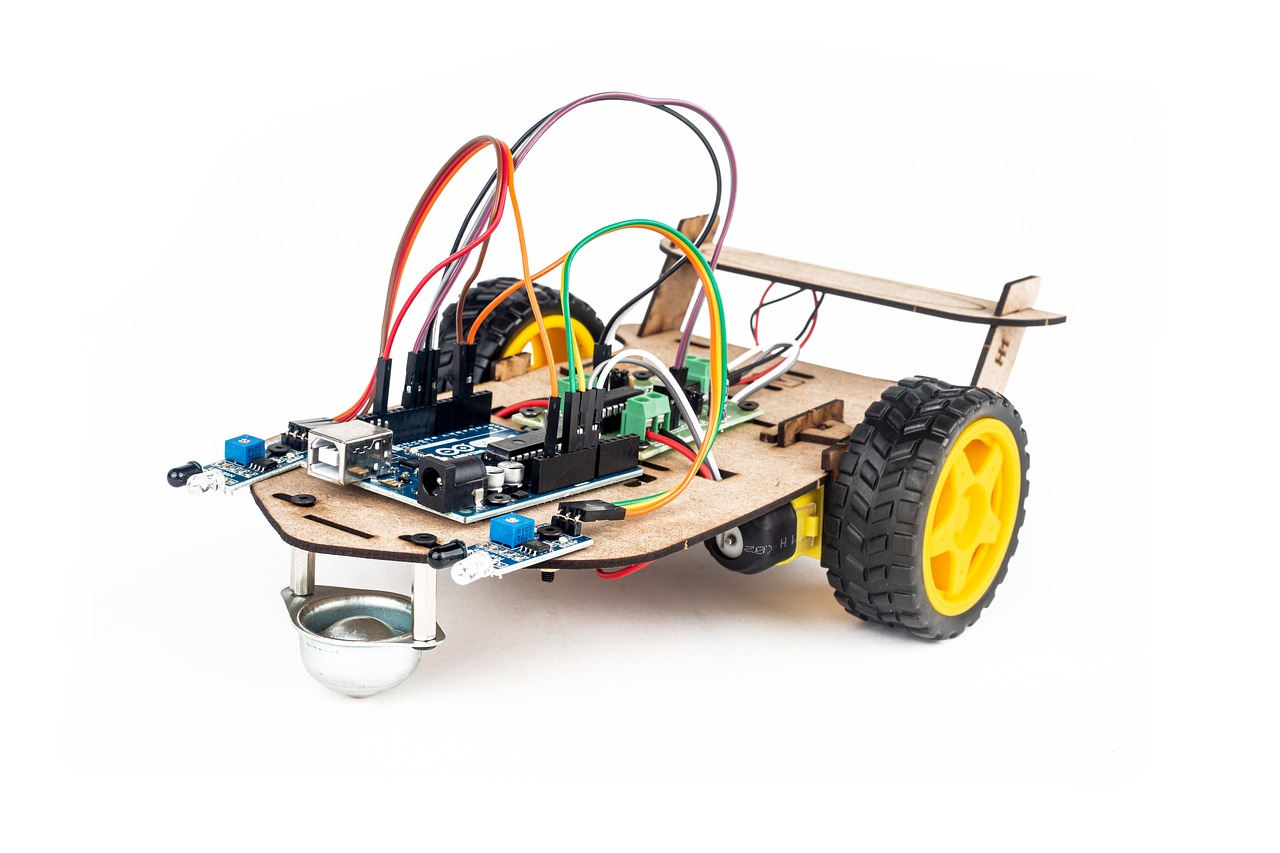
Payload Capacity
The QinetiQ Talon robot is not just a marvel of engineering; it’s a versatile tool that can adapt to various missions thanks to its impressive . This capability is crucial for Explosive Ordnance Disposal (EOD) operations, where the nature of tasks can vary significantly from one mission to another. The Talon can be outfitted with a range of tools and sensors, allowing it to tackle specific challenges effectively. Imagine being able to customize a robot to fit your needs, just like choosing the right tools for a home improvement project.
At its core, the Talon’s payload system is modular, meaning it can be easily reconfigured depending on the mission requirements. This flexibility is a game-changer in the field of EOD, where conditions may change rapidly and unpredictably. For instance, the Talon can carry:
- Robotic arms for manipulating objects
- High-definition cameras for reconnaissance
- Explosive detection sensors
- Communication equipment for real-time data transmission
This adaptability not only enhances the robot's functionality but also significantly improves the safety and effectiveness of EOD operations. Imagine sending a robot equipped with a camera into a potentially explosive situation to gather intelligence before human operators step in. This proactive approach minimizes risks and allows for better planning.
Furthermore, the Talon’s payload capacity allows for the integration of advanced technologies as they become available. As new tools and sensors are developed, the Talon can be upgraded without the need for a complete redesign. This ensures that EOD teams always have access to the best technology available, keeping them one step ahead of potential threats.
In summary, the payload capacity of the QinetiQ Talon robot is a defining feature that enhances its operational versatility. By allowing for a wide range of tools and sensors to be fitted, it not only meets the demands of various missions but also plays a critical role in ensuring the safety and efficiency of EOD operations.
- What types of sensors can the Talon carry? The Talon can carry various sensors, including explosive detection devices, high-definition cameras, and environmental sensors.
- How does the Talon's payload capacity enhance EOD operations? It allows for the customization of tools and equipment based on mission needs, improving safety and operational efficiency.
- Can the Talon operate in extreme weather conditions? While the Talon is designed for rugged environments, extreme weather can still pose challenges to its operational capabilities.
- What training is required to operate the Talon? Operators must undergo specialized training to effectively manage the robot and interpret the data it collects during missions.

Applications in EOD Missions
The QinetiQ Talon robot has carved a significant niche in the realm of Explosive Ordnance Disposal (EOD) operations. Its versatility and advanced features make it an indispensable tool for bomb disposal experts. Primarily, the Talon robot is utilized in various critical applications that enhance both safety and efficiency in high-risk environments. One of the key roles of the Talon is in reconnaissance missions. Before EOD teams approach a potentially dangerous area, the Talon can be deployed to assess the situation from a safe distance. Equipped with high-resolution cameras and sensors, it captures real-time data, allowing operators to make informed decisions without putting themselves in harm's way.
Another vital application of the Talon robot is in the neutralization of explosive devices. When a bomb is detected, traditional methods often require personnel to get dangerously close to the threat. However, with the Talon, EOD teams can employ various tools, such as robotic arms, to disarm or detonate explosives remotely. This capability not only protects personnel but also significantly reduces the risk of collateral damage in populated areas. The Talon can be fitted with different payloads tailored to specific tasks, which enhances its effectiveness in addressing various explosive threats.
Moreover, the Talon robot is invaluable in post-blast analysis. After an explosion occurs, understanding the cause and the type of explosive used is crucial for preventing future incidents. The Talon can navigate through debris and hazardous materials, collecting evidence and data that can be analyzed later. This process not only aids in forensic investigations but also helps in improving future EOD strategies.
In summary, the applications of the QinetiQ Talon robot in EOD missions are multifaceted. From reconnaissance and neutralization to post-blast analysis, the Talon enhances operational capabilities and safety for EOD teams. Its ability to adapt to various tasks makes it a game-changer in the field, ensuring that explosive threats are managed effectively and efficiently.
- What is the primary function of the QinetiQ Talon robot?
The primary function of the Talon robot is to assist EOD teams in safely detecting, assessing, and neutralizing explosive threats. - How does the Talon robot enhance safety for personnel?
By performing reconnaissance and neutralization tasks remotely, the Talon minimizes the need for personnel to approach dangerous explosive devices, significantly reducing their risk of injury or fatality. - Can the Talon robot be used in various environments?
Yes, the Talon is designed with all-terrain capabilities, allowing it to operate effectively in diverse landscapes, including urban settings and rugged terrains. - What types of sensors can be equipped on the Talon robot?
The Talon can be outfitted with various sensors, including cameras for visual assessment, chemical detectors, and other specialized tools tailored for specific EOD tasks.
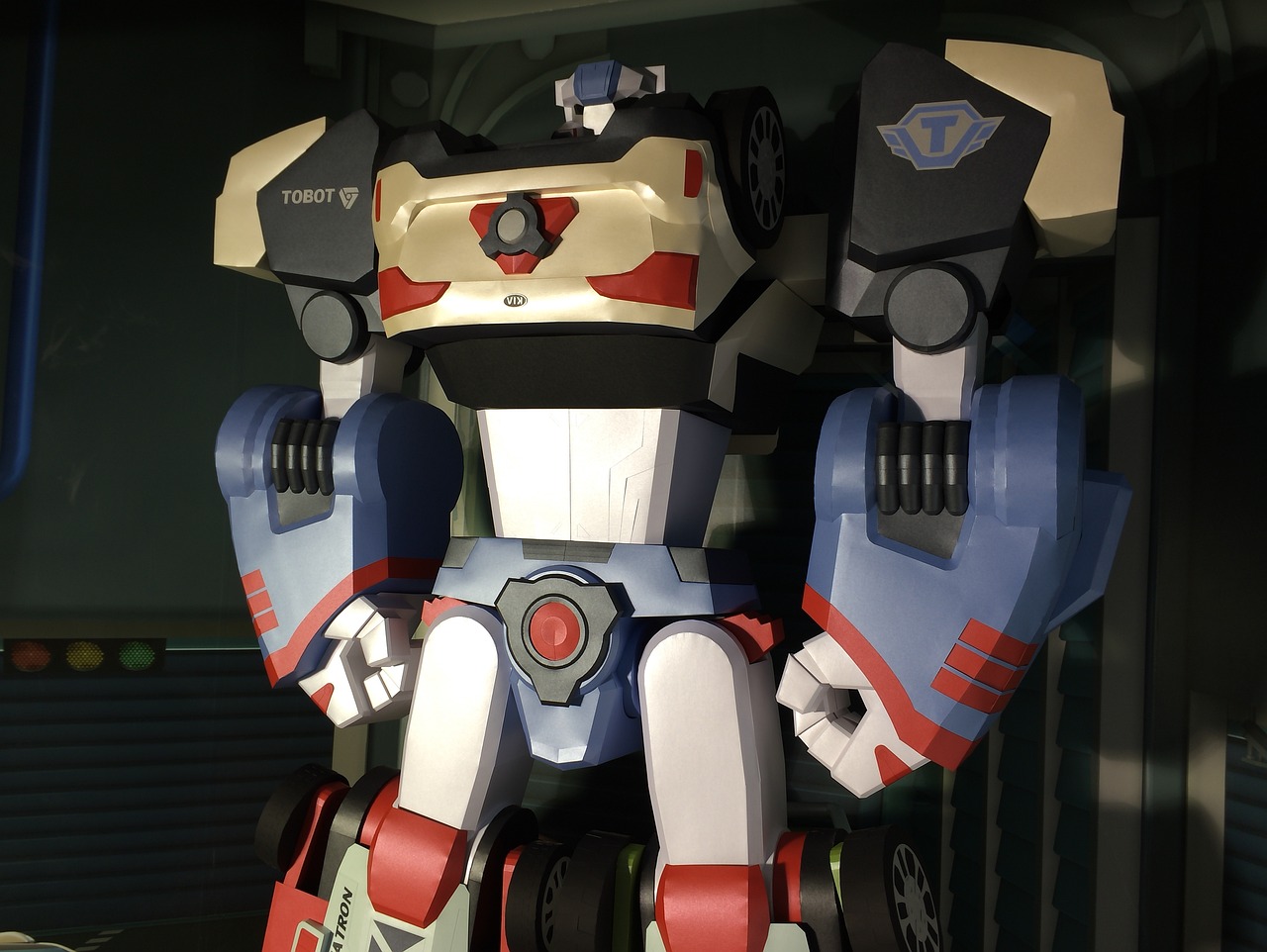
Benefits of Using Robots in EOD
The integration of robots like the QinetiQ Talon into Explosive Ordnance Disposal (EOD) operations has revolutionized the way these missions are conducted. The benefits are not just theoretical; they manifest in real-world scenarios, enhancing safety, efficiency, and overall operational effectiveness. Imagine a world where bomb disposal teams can operate from a safe distance, significantly reducing the risks associated with handling explosive devices. This is precisely what the Talon robot brings to the table.
One of the most significant advantages of using robots in EOD operations is enhanced safety for personnel. By deploying the Talon to assess and neutralize threats, EOD teams can keep themselves at a safe distance, thereby minimizing their exposure to potential explosions. This capability is particularly crucial in high-stakes situations where every second counts. The ability to control the robot remotely allows teams to make informed decisions without putting themselves in harm's way. In fact, studies have shown that the use of robots can reduce injury rates among bomb disposal personnel by up to 80%.
Moreover, the operational efficiency gained from using the Talon robot cannot be overstated. The robot's advanced sensors and tools enable rapid assessments and neutralizations of explosive devices, which translates to faster mission completions. For instance, when faced with a suspicious package, the Talon can quickly gather intelligence and relay it back to the team, allowing for quicker decision-making. This efficiency not only saves time but also reduces the overall downtime for EOD operations, allowing teams to respond to multiple incidents in a shorter timeframe.
Additionally, the Talon robot enhances situational awareness during missions. Equipped with high-definition cameras and sensors, the robot can provide real-time video feeds and data analysis, giving operators a comprehensive view of the operational environment. This capability is akin to having a "bird's eye view" of the situation, allowing teams to strategize effectively and respond to evolving threats with agility.
Furthermore, the adaptability of the Talon robot allows it to be configured for various tasks beyond just bomb disposal. For example, it can be outfitted with different payloads for reconnaissance, chemical detection, or even surveillance. This versatility means that the same robot can be employed across different scenarios, maximizing the return on investment for EOD units.
In summary, the benefits of using robots like the QinetiQ Talon in EOD operations are profound. They not only enhance the safety of personnel but also improve operational efficiency and situational awareness. As technology continues to evolve, the role of robots in these critical missions will likely expand, paving the way for even safer and more effective EOD operations.
- What is the primary purpose of the QinetiQ Talon robot?
The Talon robot is primarily used for Explosive Ordnance Disposal (EOD) operations, allowing teams to safely assess and neutralize explosive threats from a distance. - How does the Talon enhance safety for EOD personnel?
By deploying the robot to handle explosive threats, EOD teams can minimize their exposure to danger, significantly reducing the risk of injury or fatality. - Can the Talon robot be used for tasks other than bomb disposal?
Yes, the Talon is versatile and can be equipped for various missions, including reconnaissance and surveillance, making it a valuable asset in multiple scenarios. - What are the limitations of using the Talon robot?
While the Talon is equipped with advanced technology, it may encounter limitations in extreme weather conditions or complex urban environments, requiring skilled operators for effective use.

Enhanced Safety for Personnel
This article explores the significance of the QinetiQ Talon robot in Explosive Ordnance Disposal (EOD) operations, highlighting its capabilities, applications, and impact on safety and efficiency in the field.
EOD operations require specialized techniques and equipment to safely neutralize explosive threats. Understanding the context and challenges of these operations is essential for appreciating the role of robots like the QinetiQ Talon.
The QinetiQ Talon robot is a versatile unmanned ground vehicle designed for various missions. Its robust design and advanced features make it a valuable asset in hazardous environments, particularly in EOD scenarios.
The Talon robot boasts a rugged design, all-terrain capabilities, and modular components. These features enable it to navigate diverse landscapes and perform a range of tasks in challenging conditions.
The Talon's unique mobility allows it to traverse difficult terrains, including rubble and steep inclines, ensuring effective operation in various environments where traditional vehicles may struggle.
With its customizable payload options, the Talon can be equipped with various tools and sensors, enhancing its functionality for specific EOD tasks and improving mission adaptability.
The Talon robot is utilized in numerous EOD applications, from reconnaissance to neutralization of explosive devices. Its deployment enhances operational safety and efficiency, reducing risks for personnel.
Integrating robots like the Talon into EOD operations provides significant advantages, including improved safety for bomb disposal teams, increased operational efficiency, and enhanced situational awareness during missions.
One of the most compelling reasons for using the QinetiQ Talon robot in EOD operations is the enhanced safety it provides for personnel. Imagine being in a situation where a potential explosive device is lurking just around the corner. The tension is palpable, and every second counts. Instead of sending a human into that dangerous scenario, the Talon can be deployed to assess the situation, significantly reducing the risk of injury or fatality.
The Talon robot acts as a protective shield for EOD teams, allowing them to operate from a safe distance. This capability is crucial in high-stakes environments where the slightest mistake can have catastrophic consequences. By utilizing the Talon, teams can:
- Minimize Exposure: The robot can approach and inspect suspicious objects without putting human lives on the line.
- Remote Operation: Operators can control the Talon from a safe distance, ensuring they are out of harm's way while still effectively managing the mission.
- Real-time Data: The Talon can relay vital information back to the team, allowing them to make informed decisions without exposing themselves to danger.
Furthermore, the Talon’s advanced sensors and cameras provide a comprehensive view of the environment, enabling EOD teams to identify threats more accurately. This situational awareness is invaluable in crisis situations, where quick and decisive action is necessary. In essence, the Talon not only enhances safety but also empowers personnel with the information they need to tackle explosive threats effectively.
Despite its advantages, the QinetiQ Talon robot faces challenges, including technical limitations, environmental factors, and the need for skilled operators. Understanding these challenges is crucial for effective deployment.
While the Talon is equipped with advanced technology, it may encounter limitations in certain environments, such as extreme weather conditions or complex urban settings that challenge its operational capabilities.
Effective utilization of the Talon requires trained personnel who can operate the robot and interpret its data. Ensuring operators are well-trained is essential for mission success.
The field of EOD robotics is continually evolving, with advancements in technology promising to enhance the capabilities of robots like the Talon. Future developments may lead to even safer and more efficient operations.
- How does the Talon robot improve safety for EOD personnel?
The Talon robot minimizes personnel exposure to dangerous environments by allowing remote operation and providing real-time data from the field. - What types of sensors can be equipped on the Talon?
The Talon can be outfitted with various sensors, including cameras, chemical detectors, and robotic arms for neutralizing threats. - Are there any limitations to the Talon robot?
Yes, the Talon may face challenges in extreme weather conditions or complex urban environments that could hinder its operational capabilities.

Operational Efficiency
The integration of the QinetiQ Talon robot into Explosive Ordnance Disposal (EOD) operations has revolutionized the way these critical missions are conducted. One of the most significant advantages of deploying the Talon is its ability to enhance operational efficiency. Imagine a scenario where a bomb disposal team is faced with a potential explosive threat. Traditionally, this would require a team of experts to approach the site, assess the situation, and neutralize the threat, all while putting their lives at risk. However, with the Talon robot at their disposal, the entire process becomes more streamlined and effective.
What sets the Talon apart is its capability to perform quick assessments and execute neutralization tasks with precision. This not only reduces the time spent on-site but also minimizes the risk factors involved. For instance, the Talon can be remotely operated from a safe distance, allowing EOD personnel to maintain a protective buffer while still effectively managing the situation. This leads to faster decision-making and prompt actions, which are crucial during high-stakes operations.
Furthermore, the Talon’s advanced sensors and imaging systems provide real-time data and situational awareness. This means that operators can make informed decisions based on accurate information rather than assumptions. The ability to gather intelligence quickly allows teams to prioritize their actions and allocate resources more effectively. Here’s a brief overview of how the Talon contributes to operational efficiency:
| Feature | Benefit |
|---|---|
| Remote Operation | Minimizes personnel exposure to danger |
| Real-Time Data Collection | Informed decision-making and prioritization |
| Rapid Deployment | Quicker threat neutralization and mission completion |
In essence, the Talon robot acts as a force multiplier in EOD operations. By handling the more dangerous aspects of the job, it allows human operators to focus on strategy and analysis rather than direct exposure to threats. This shift not only enhances the safety of the team but also leads to faster mission completions and reduced downtime between operations. As EOD missions often involve unpredictable variables, the Talon’s efficiency in adapting to various scenarios is invaluable.
Ultimately, the operational efficiency brought about by the QinetiQ Talon robot is a game-changer in the realm of EOD. It empowers teams to respond to threats with greater speed and safety, ensuring that they can carry out their critical missions effectively. The future of EOD operations looks bright, with robots like the Talon leading the way toward safer and more efficient practices.
- What is the QinetiQ Talon robot used for?
The Talon robot is primarily used in Explosive Ordnance Disposal (EOD) operations to safely neutralize explosive threats. - How does the Talon enhance safety in EOD operations?
By allowing operators to control the robot from a distance, the Talon minimizes human exposure to dangerous situations. - What types of sensors can be equipped on the Talon?
The Talon can be outfitted with various sensors, including cameras, chemical detectors, and robotic arms for handling explosives. - Are there any limitations to the Talon robot?
Yes, while the Talon is highly capable, it may face challenges in extreme weather conditions or complex environments.

Challenges and Limitations
While the QinetiQ Talon robot has revolutionized the way we approach Explosive Ordnance Disposal (EOD) operations, it is not without its challenges and limitations. Understanding these hurdles is essential for optimizing its deployment and ensuring mission success. One of the primary challenges is the technical limitations that the Talon may face in certain environments. For instance, extreme weather conditions such as heavy rain, snow, or intense heat can hinder its operational capabilities. Additionally, complex urban settings pose a unique challenge, where obstacles like narrow alleys, debris, and uneven surfaces can affect the robot's mobility and maneuverability.
Moreover, the need for skilled operators cannot be overstated. While the Talon is equipped with advanced technology, it requires trained personnel who are adept at operating the robot and interpreting the data it collects. The success of an EOD mission often hinges on the operator's ability to make quick decisions based on the information provided by the Talon. This necessitates a rigorous training program to ensure that operators are not only familiar with the robot's functions but also capable of responding to unexpected situations that may arise during operations.
Another challenge is the cost of maintenance and upgrades. As technology evolves, the need for regular updates and maintenance becomes essential to keep the Talon at peak performance. This can be a significant investment for organizations, especially those operating on limited budgets. Additionally, the integration of new technologies may require further training for operators, adding another layer of complexity to the deployment process.
Finally, the reliance on technology can also be a double-edged sword. While the Talon enhances safety and efficiency, over-reliance on robotic systems may lead to complacency among EOD teams. It is crucial to maintain a balance between human intuition and robotic assistance to ensure that teams are prepared for any scenario, including those where the robot may fail or be incapacitated.
In summary, while the QinetiQ Talon robot offers numerous advantages in EOD operations, it is essential to recognize and address its challenges. By doing so, organizations can maximize the benefits of this innovative technology and ensure safer, more effective bomb disposal missions.
- What are the main challenges faced by the QinetiQ Talon robot?
The main challenges include technical limitations in extreme environments, the need for skilled operators, maintenance costs, and the potential for over-reliance on technology. - How does weather affect the Talon's performance?
Extreme weather conditions such as heavy rain, snow, or heat can hinder the robot's mobility and operational capabilities. - Why is operator training important for the Talon robot?
Trained operators are essential for effectively utilizing the robot and interpreting its data, which is crucial for the success of EOD missions. - What are the costs associated with maintaining the Talon?
Maintaining the Talon involves costs related to regular updates, repairs, and potential additional training for operators. - Can the Talon operate in urban environments?
While the Talon is designed for versatility, complex urban settings can pose challenges due to obstacles and uneven terrains.

Technical Limitations
The QinetiQ Talon robot, while a remarkable piece of technology, is not without its challenges. One of the primary technical limitations stems from its operational environment. Extreme weather conditions, such as heavy rain, snow, or intense heat, can significantly impact the robot's performance. For instance, when navigating through muddy or flooded terrains, the Talon may struggle to maintain traction, leading to potential mobility issues. Similarly, in icy conditions, its wheels may not grip the surface effectively, making it difficult to maneuver.
Moreover, the complexity of urban settings poses another hurdle. The Talon is designed to operate in various terrains, but densely populated areas filled with obstacles—like debris, narrow alleyways, and uneven surfaces—can challenge its navigation systems. In these scenarios, the robot might require additional time to assess its surroundings and find a safe path, which could delay critical missions.
Another limitation is related to its payload capacity. While the Talon can be equipped with various tools and sensors, there is a maximum weight it can carry. If the payload exceeds this limit, the robot's mobility and battery life can be adversely affected. This constraint necessitates careful planning and selection of equipment, ensuring that the Talon can perform its tasks effectively without compromising its operational efficiency.
Furthermore, the reliance on advanced technology means that any technical malfunction can lead to significant setbacks. For instance, if the robot's communication systems fail, operators may lose control or data transmission, which could endanger the mission. Regular maintenance and updates are essential to mitigate this risk, but they also require time and resources.
Lastly, the need for skilled operators cannot be overstated. While the Talon is designed to be user-friendly, it still requires trained personnel to navigate its complexities. Operators must be adept not only in controlling the robot but also in interpreting the data it collects. Without this expertise, the full potential of the Talon may not be realized, leading to suboptimal mission outcomes.
- What are the main advantages of using the QinetiQ Talon robot in EOD operations?
The Talon enhances safety for personnel, increases operational efficiency, and improves situational awareness during missions. - Can the Talon robot operate in all weather conditions?
While the Talon is designed for versatility, extreme weather conditions can limit its operational capabilities. - How does the Talon handle complex urban environments?
The Talon can navigate urban settings but may face challenges due to obstacles and uneven surfaces that can affect its mobility. - Is specialized training required to operate the Talon robot?
Yes, trained personnel are essential to effectively operate the Talon and interpret its data for successful mission execution.
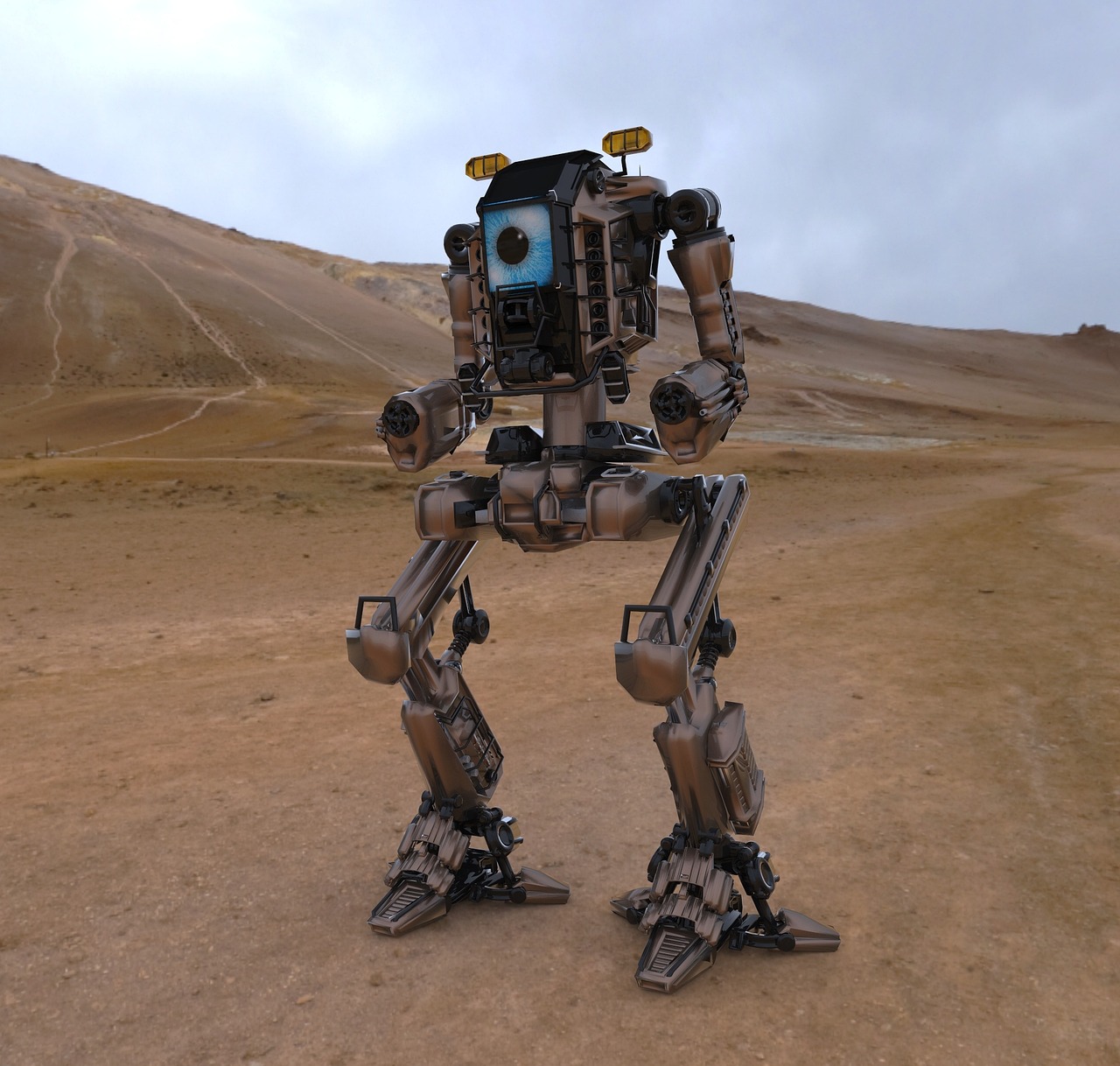
Need for Skilled Operators
The successful deployment of the QinetiQ Talon robot in EOD operations hinges not just on its impressive technological capabilities, but significantly on the expertise of the operators who control it. Imagine handing over the keys to a high-performance sports car to someone who has never driven before; the potential for mishaps is enormous. Similarly, the Talon robot, while equipped with cutting-edge technology, requires skilled personnel who can navigate its functionalities and interpret the data it gathers. Without this expertise, the robot's capabilities can go underutilized, and critical decisions made in high-pressure situations can falter.
Training operators to handle the Talon effectively involves a comprehensive understanding of both the robot's hardware and software. Operators must be adept at maneuvering the robot in various terrains, understanding its payload options, and utilizing the sensors for reconnaissance. Moreover, they must be able to make quick decisions based on real-time data, which can often mean the difference between success and failure in EOD missions. This necessity for skilled operators also extends to understanding the environmental challenges that may impact the robot's performance, such as navigating through debris or adapting to adverse weather conditions.
Furthermore, the need for skilled operators is not just about handling the technology but also about communication and teamwork. EOD operations often involve multiple team members working in concert, where the operator must relay information back to the command center while ensuring that safety protocols are adhered to. This coordination is vital, especially when dealing with high-stakes scenarios where every second counts. Therefore, investing in rigorous training programs that combine technical skills with practical field experience is essential for maximizing the effectiveness of the Talon robot in EOD missions.
In summary, while the QinetiQ Talon robot is a formidable tool in the arsenal of EOD operations, its success is largely dependent on the skilled operators behind the controls. The blend of technical training, environmental awareness, and teamwork can turn a potentially dangerous situation into a controlled and safe operation, ultimately enhancing the overall effectiveness of EOD missions.
- What is the QinetiQ Talon robot used for?
The Talon robot is primarily used in Explosive Ordnance Disposal (EOD) operations to safely neutralize explosive threats, conduct reconnaissance, and enhance operational safety. - How does the Talon robot improve safety for EOD teams?
By handling dangerous tasks remotely, the Talon robot minimizes the exposure of EOD personnel to potential explosive hazards, significantly reducing the risk of injury or fatality. - What kind of training do operators need to control the Talon robot?
Operators require comprehensive training that covers the robot's technical capabilities, environmental challenges, and effective communication skills for successful teamwork in high-pressure situations. - Are there any limitations to the Talon robot?
Yes, the Talon robot may face challenges in extreme weather conditions or complex urban environments, which can affect its operational capabilities. - What advancements are expected in EOD robotics in the future?
Future developments may include enhanced autonomy, improved sensors, and better integration with other technologies, leading to safer and more efficient EOD operations.
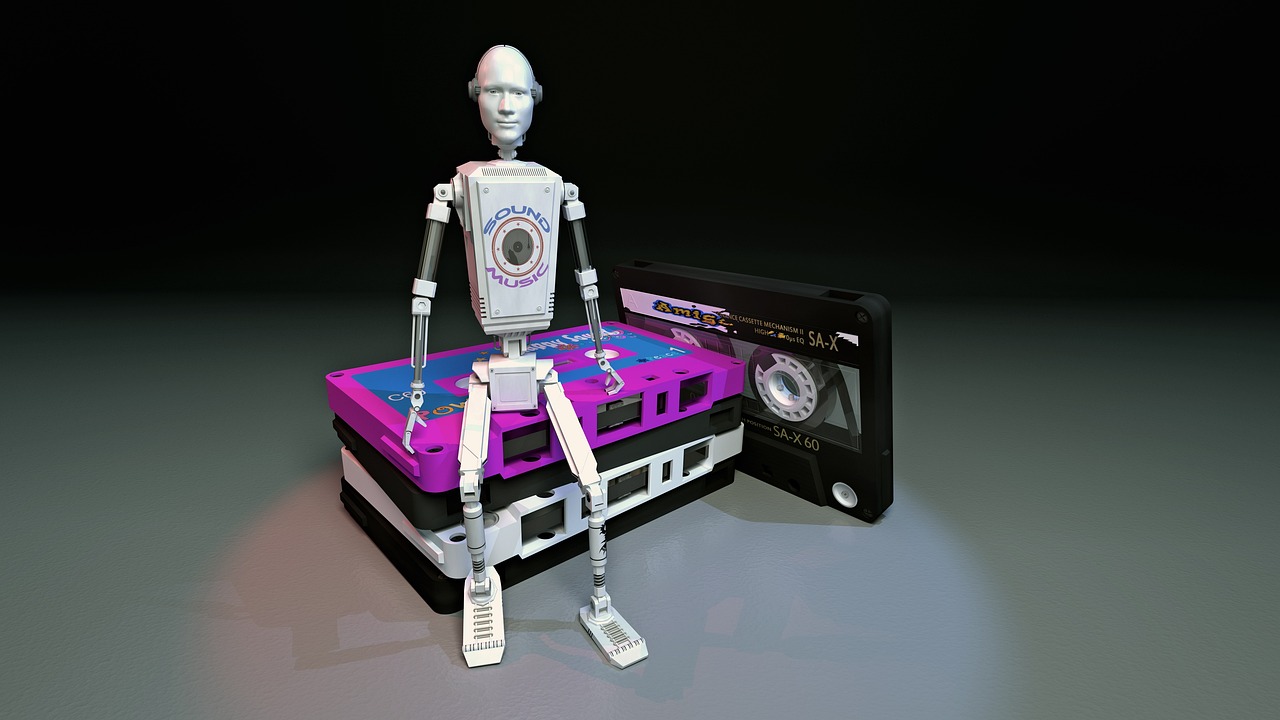
Future Developments in EOD Robotics
The landscape of Explosive Ordnance Disposal (EOD) robotics is on the brink of a remarkable transformation. As technology continues to advance at an unprecedented pace, we can expect significant innovations that will enhance the capabilities of robots like the QinetiQ Talon. Imagine a future where robots are not only more autonomous but also equipped with advanced artificial intelligence (AI) that allows them to make real-time decisions. This leap in technology could revolutionize how EOD teams approach dangerous situations.
One of the most exciting prospects for future EOD robotics is the integration of machine learning algorithms. These algorithms would enable robots to learn from past experiences, improving their ability to identify and neutralize threats. For instance, a Talon robot could analyze data from previous missions and adapt its strategies accordingly, making it more effective in various scenarios. This adaptability is crucial, especially in unpredictable environments where every second counts.
Furthermore, advancements in sensing technologies promise to enhance situational awareness for EOD teams. Future robots may be equipped with sophisticated sensors that can detect a wider range of explosives and hazardous materials. Imagine a robot that can not only identify the type of explosive but also assess its stability and potential risks. This capability would allow EOD personnel to plan their operations with greater precision, significantly increasing safety.
Another area of development is the collaboration between robots and human operators. Future EOD missions could involve teams of robots working in tandem with human experts, sharing data and insights in real-time. This collaborative approach would leverage the strengths of both humans and machines, creating a more effective and safer operational environment. For example, while a robot handles the physical tasks of neutralizing a bomb, a human operator could focus on decision-making and strategy, ensuring that every move is calculated and informed.
Moreover, the future of EOD robotics may also see the emergence of swarm technology. This concept involves deploying multiple robots that can communicate and coordinate with each other. Imagine a swarm of Talon robots working together to survey a large area for potential threats, sharing information and covering ground more efficiently than a single unit could. This not only enhances operational efficiency but also reduces the time spent in high-risk zones.
Finally, as the demand for EOD capabilities grows globally, we can expect to see increased investment in research and development. This influx of resources will likely accelerate the pace of innovation, leading to more robust, reliable, and versatile robotic solutions for EOD operations. The future is bright, and the potential for EOD robotics is limitless.
- What is the QinetiQ Talon robot?
The QinetiQ Talon is an unmanned ground vehicle designed for various military and civilian applications, particularly in Explosive Ordnance Disposal (EOD) operations. - How does the Talon robot enhance safety in EOD operations?
By deploying the Talon robot to handle explosive threats, EOD teams minimize their exposure to danger, significantly reducing the risk of injury or fatality. - What future technologies are expected to improve EOD robotics?
Future developments may include enhanced machine learning algorithms, advanced sensing technologies, improved collaboration between robots and humans, and swarm technology. - What challenges do EOD robots face?
Challenges include technical limitations in certain environments, the need for skilled operators, and the potential for extreme weather conditions affecting performance.
Frequently Asked Questions
- What is the QinetiQ Talon robot?
The QinetiQ Talon robot is a versatile unmanned ground vehicle specifically designed for Explosive Ordnance Disposal (EOD) operations. Its robust design and advanced features make it an invaluable asset in hazardous environments, allowing for safer and more efficient handling of explosive threats.
- How does the Talon robot enhance safety during EOD operations?
By deploying the Talon robot to handle explosive devices, EOD teams can significantly reduce their exposure to danger. The robot can assess and neutralize threats from a safe distance, minimizing the risk of injury or fatality for personnel involved in the operation.
- What are the key design features of the Talon robot?
The Talon robot boasts a rugged design with all-terrain capabilities. It is equipped with modular components that allow for customization of payloads, enabling it to perform a variety of tasks in challenging conditions, such as navigating through rubble or steep inclines.
- What applications does the Talon robot have in EOD missions?
The Talon robot is used in various EOD applications, including reconnaissance, assessment, and neutralization of explosive devices. Its deployment enhances operational safety and efficiency, allowing teams to complete missions more quickly and effectively.
- What are some challenges faced by the Talon robot?
Despite its advantages, the Talon robot faces challenges such as technical limitations in extreme weather conditions or complex urban environments. Additionally, effective utilization requires skilled operators who can manage the robot and interpret its data accurately.
- How does the Talon robot improve operational efficiency?
The Talon robot streamlines EOD processes, allowing for quicker assessments and neutralizations of threats. This increased efficiency can lead to faster mission completions and reduced downtime, making operations more effective overall.
- What is the future of EOD robotics?
The field of EOD robotics is continuously advancing, with ongoing developments in technology expected to enhance the capabilities of robots like the Talon. Future innovations may lead to even safer and more efficient operations in the realm of explosive ordnance disposal.

